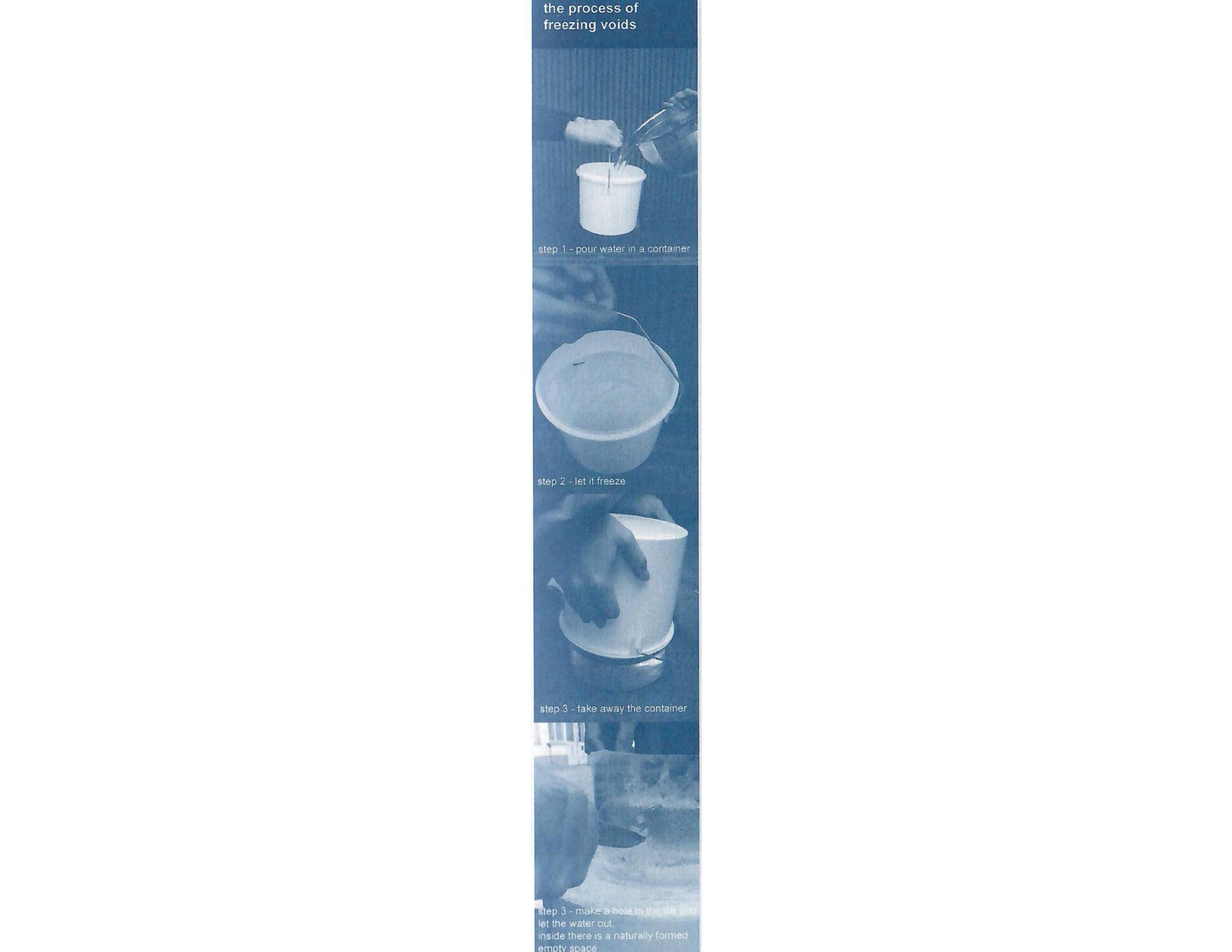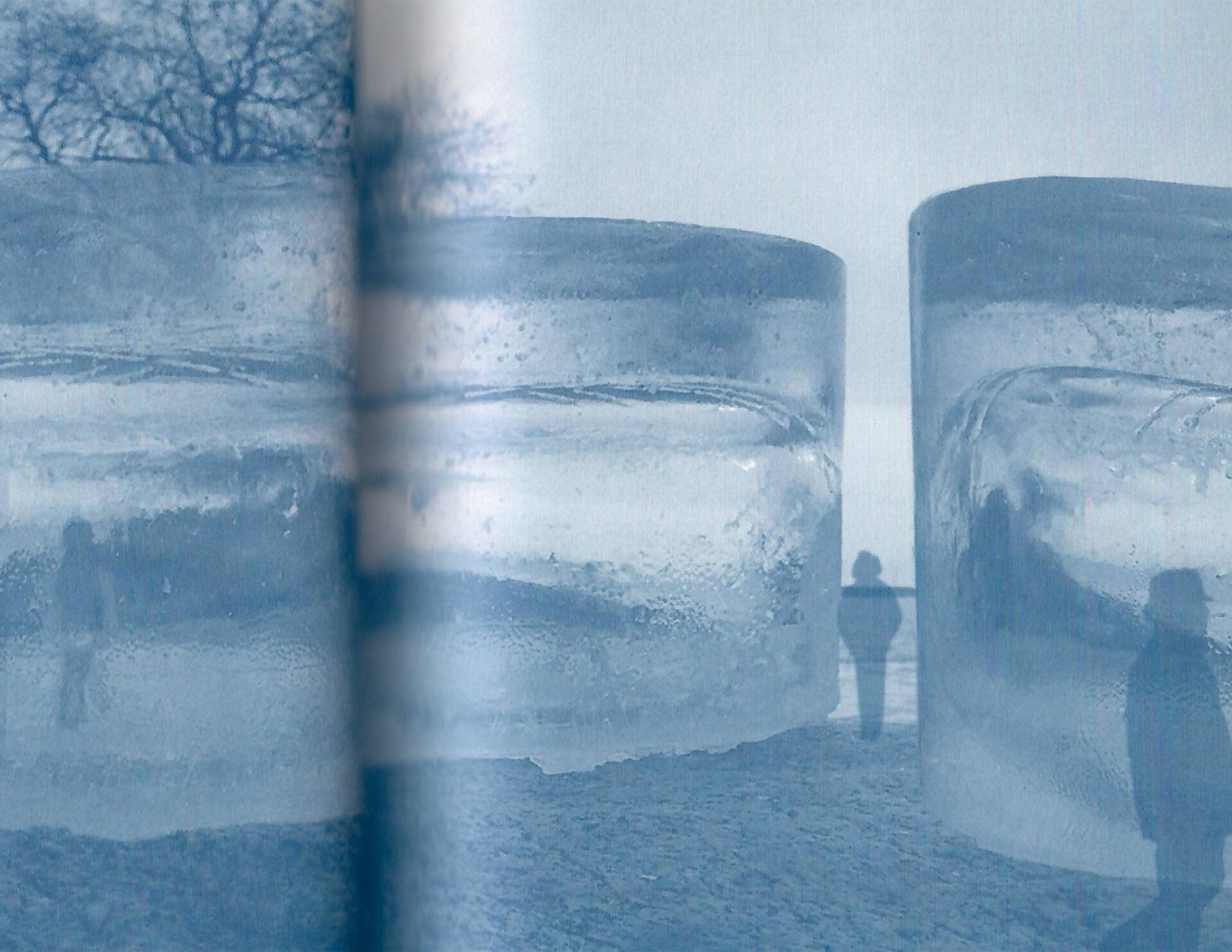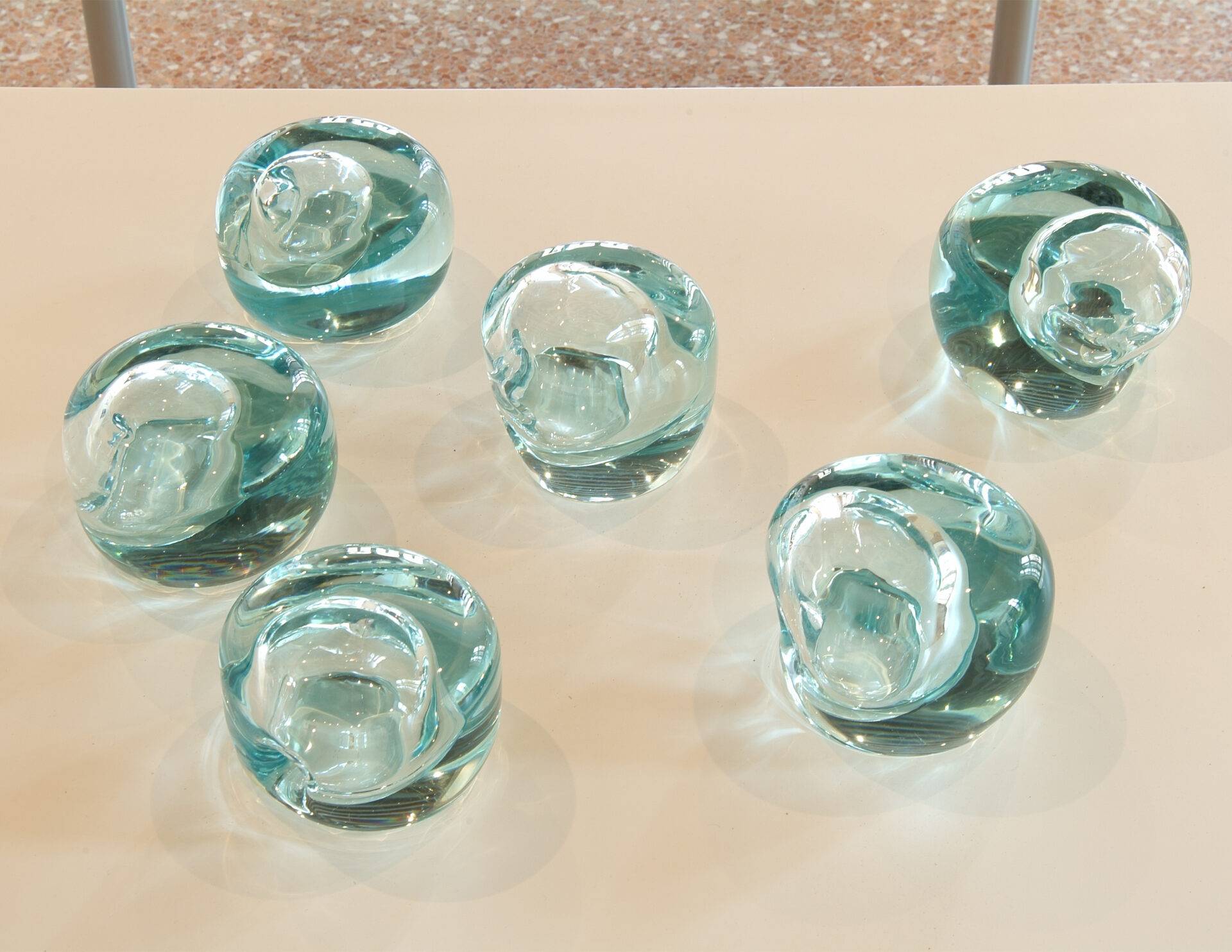FROZEN VOIDS
2003
Ernesto Neto & Ocean North
Ernesto Neto with Tuuli & Kivi Sotamaa:
The idea for Frozen Voids came from a popular Finnish tradition of making ice lanterns. The lanterns are made by freezing water overnight in a bucket. During the nigh the water freezes on the perimeter of the bucket but remains liquid on the inside. The next morning the block of ice is taken out and a small hole is made to let the liquid out. What is left is a beautiful naturally formed blob-like void inside a frozen cylinder. A candle is placed into the void. The lanterns are used to create festive outdoor lighting during the dark winter months.
Ernesto Neto with Tuuli & Kivi Sotamaa:
The idea for Frozen Voids came from a popular Finnish tradition of making ice lanterns. The lanterns are made by freezing water overnight in a bucket. During the nigh the water freezes on the perimeter of the bucket but remains liquid on the inside. The next morning the block of ice is taken out and a small hole is made to let the liquid out. What is left is a beautiful naturally formed blob-like void inside a frozen cylinder. A candle is placed into the void. The lanterns are used to create festive outdoor lighting during the dark winter months.
Our plan is to use the same process to create a series of large frozen cylinders which contain a naturally formed empty space. The intention is to make up to five cylinders and interconnect them in order to create a sequence of naturally sculpted spaces. Each of the spaces will be different due to the variation temperature and its affects on the freezing process. The cylinders will be built over a set of fibreoptic lights in order to illuminate them.
FROZEN VOIDS
2003
Ernesto Neto & Ocean North
Ernesto Neto with Tuuli & Kivi Sotamaa:
The idea for Frozen Voids came from a popular Finnish tradition of making ice lanterns. The lanterns are made by freezing water overnight in a bucket. During the nigh the water freezes on the perimeter of the bucket but remains liquid on the inside. The next morning the block of ice is taken out and a small hole is made to let the liquid out. What is left is a beautiful naturally formed blob-like void inside a frozen cylinder. A candle is placed into the void. The lanterns are used to create festive outdoor lighting during the dark winter months.
Ernesto Neto with Tuuli & Kivi Sotamaa:
The idea for Frozen Voids came from a popular Finnish tradition of making ice lanterns. The lanterns are made by freezing water overnight in a bucket. During the nigh the water freezes on the perimeter of the bucket but remains liquid on the inside. The next morning the block of ice is taken out and a small hole is made to let the liquid out. What is left is a beautiful naturally formed blob-like void inside a frozen cylinder. A candle is placed into the void. The lanterns are used to create festive outdoor lighting during the dark winter months.
Our plan is to use the same process to create a series of large frozen cylinders which contain a naturally formed empty space. The intention is to make up to five cylinders and interconnect them in order to create a sequence of naturally sculpted spaces. Each of the spaces will be different due to the variation temperature and its affects on the freezing process. The cylinders will be built over a set of fibreoptic lights in order to illuminate them.
FROZEN VOIDS
2003
Ernesto Neto & Ocean North
Ernesto Neto with Tuuli & Kivi Sotamaa:
The idea for Frozen Voids came from a popular Finnish tradition of making ice lanterns. The lanterns are made by freezing water overnight in a bucket. During the nigh the water freezes on the perimeter of the bucket but remains liquid on the inside. The next morning the block of ice is taken out and a small hole is made to let the liquid out. What is left is a beautiful naturally formed blob-like void inside a frozen cylinder. A candle is placed into the void. The lanterns are used to create festive outdoor lighting during the dark winter months.
Ernesto Neto with Tuuli & Kivi Sotamaa:
The idea for Frozen Voids came from a popular Finnish tradition of making ice lanterns. The lanterns are made by freezing water overnight in a bucket. During the nigh the water freezes on the perimeter of the bucket but remains liquid on the inside. The next morning the block of ice is taken out and a small hole is made to let the liquid out. What is left is a beautiful naturally formed blob-like void inside a frozen cylinder. A candle is placed into the void. The lanterns are used to create festive outdoor lighting during the dark winter months.
Our plan is to use the same process to create a series of large frozen cylinders which contain a naturally formed empty space. The intention is to make up to five cylinders and interconnect them in order to create a sequence of naturally sculpted spaces. Each of the spaces will be different due to the variation temperature and its affects on the freezing process. The cylinders will be built over a set of fibreoptic lights in order to illuminate them.
FROZEN VOIDS
2003
Ernesto Neto & Ocean North
Ernesto Neto with Tuuli & Kivi Sotamaa:
The idea for Frozen Voids came from a popular Finnish tradition of making ice lanterns. The lanterns are made by freezing water overnight in a bucket. During the nigh the water freezes on the perimeter of the bucket but remains liquid on the inside. The next morning the block of ice is taken out and a small hole is made to let the liquid out. What is left is a beautiful naturally formed blob-like void inside a frozen cylinder. A candle is placed into the void. The lanterns are used to create festive outdoor lighting during the dark winter months.
Ernesto Neto with Tuuli & Kivi Sotamaa:
The idea for Frozen Voids came from a popular Finnish tradition of making ice lanterns. The lanterns are made by freezing water overnight in a bucket. During the nigh the water freezes on the perimeter of the bucket but remains liquid on the inside. The next morning the block of ice is taken out and a small hole is made to let the liquid out. What is left is a beautiful naturally formed blob-like void inside a frozen cylinder. A candle is placed into the void. The lanterns are used to create festive outdoor lighting during the dark winter months.
Our plan is to use the same process to create a series of large frozen cylinders which contain a naturally formed empty space. The intention is to make up to five cylinders and interconnect them in order to create a sequence of naturally sculpted spaces. Each of the spaces will be different due to the variation temperature and its affects on the freezing process. The cylinders will be built over a set of fibreoptic lights in order to illuminate them.
ARTWORK
ARTWORK
ARTWORK








